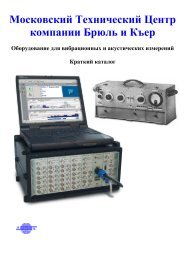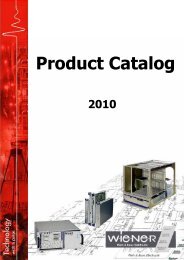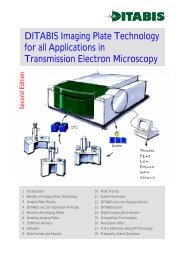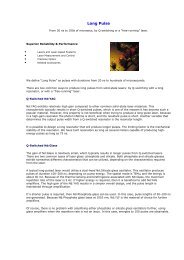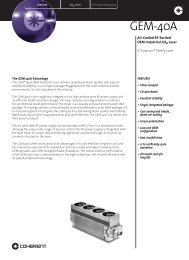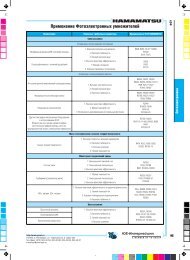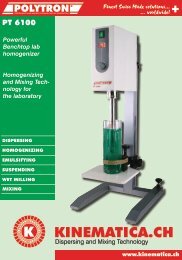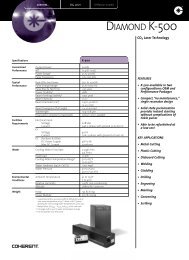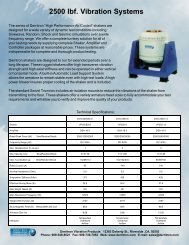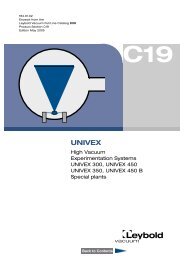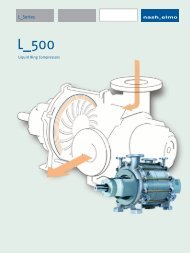- Page 1:
Laboratory Product Catalogue Total
- Page 5 and 6:
About Sartorius Sartorius AG is an
- Page 7 and 8:
Filtration Applications Major Filtr
- Page 9 and 10:
Concentration of Proteins The Sarto
- Page 11 and 12:
Comparison of the adsorption of var
- Page 13 and 14:
Other water testings 142 mm diamete
- Page 15 and 16:
Filtration Filtration Membrane Filt
- Page 17 and 18:
Order numbers for cellulose acetate
- Page 19 and 20:
Polyethersulfone Membrane Filters,
- Page 21 and 22:
Order numbers for cellulose nitrate
- Page 23 and 24:
Hydrophobic PTFE Membrane Filters,
- Page 25 and 26:
Polycarbonate Track-Etch-Membrane F
- Page 27 and 28:
Ultrafiltration Membrane Filters fr
- Page 29 and 30:
Minisart ® 0.2 µm Syringe Filter
- Page 31 and 32:
Specifications for Minisarts, Minis
- Page 33 and 34:
Minisart-NY25 (Nylon) Versatile fil
- Page 35 and 36:
Order numbers for Minisart SRP4 178
- Page 37 and 38:
Polycarbonate holder for aqueous so
- Page 39 and 40:
Polycarbonate holder for aqueous so
- Page 41 and 42:
Accessories for Ready-to-Use Minisa
- Page 43 and 44:
25 mm Glass Holder for the Filtrati
- Page 45 and 46:
All-glass Holder for Particle Remov
- Page 47 and 48:
Order numbers for 47 mm polycarbona
- Page 49 and 50:
Water jet pump with G3/4 female thr
- Page 51 and 52:
Sartolab ® P20 and Sartolab ® P20
- Page 53 and 54:
SartoScale Filter Test Disposables
- Page 55 and 56:
Sartobran ® P 150 and Sartobran ®
- Page 57 and 58:
Type 00, with hose nipple inlet and
- Page 59 and 60:
Order numbers for Sartopore 150 Wit
- Page 61 and 62:
Type 00, with hose nipple inlet and
- Page 63 and 64:
Type 00, with hose nipple inlet and
- Page 65 and 66:
Type 00, with hose nipple inlet and
- Page 67 and 68:
Mini Filter Cartridges for the Part
- Page 69 and 70:
Sartoclear ® P Depth Filter Capsul
- Page 71 and 72:
Low-Cost Polycarbonate Holder for t
- Page 73 and 74:
47 mm Stainless Steel Filter Holder
- Page 75 and 76:
142 mm in-line PTFE holder This fil
- Page 77 and 78:
Stainless Steel Holder with 2 Liter
- Page 79 and 80:
GMP-complying 142 mm Stainless Stee
- Page 81 and 82:
Modular Assembly System for Stainle
- Page 83 and 84:
Filtration Systems with Pressure Ta
- Page 85 and 86:
Order numbers 17530 5 liter capacit
- Page 87 and 88:
With commercially available hoses T
- Page 89 and 90:
Order numbers for PTFE pressure hos
- Page 91 and 92:
Order numbers for Midisart 2000 uni
- Page 93 and 94:
Sartofluor ® MidiCaps with PTFE Me
- Page 95 and 96:
Hydrophobic PTFE Membranes, Type 11
- Page 97 and 98:
25 mm Stainless Steel Filter Holder
- Page 99 and 100:
Sartofluor ® Mini Cartridges for H
- Page 101 and 102:
Housings for Sterile Air Venting an
- Page 103 and 104: Ordering information Vivaspin 2, 0.
- Page 105 and 106: Ordering information Vivaspin 15, 2
- Page 107 and 108: Vivapore Solvent Absorption Concent
- Page 109 and 110: Ordering information Vivacell 70, 1
- Page 111 and 112: Sartocon ® Slice The Pilot-Scale C
- Page 113 and 114: Specifications Drive Motor 24 V DC
- Page 115 and 116: Sartocon ® Slice 200 Stainless Ste
- Page 117 and 118: Filter Papers Introduction Generall
- Page 119 and 120: Chemical Compatibility 1. Filter Ma
- Page 121 and 122: 2. Filter Holder, Cartridge Housing
- Page 123 and 124: 3. Ready-to-Connect Filtration Unit
- Page 125 and 126: Membrane Chromatography Membrane Ch
- Page 127 and 128: Vivapure AdenePACK 100 Vivawell Met
- Page 129 and 130: Sartobind ® The Pace Maker in Memb
- Page 131 and 132: Technical data Sartobind MA ion exc
- Page 133 and 134: Product and ordering information Sa
- Page 135 and 136: Sartobind ® System For a complete
- Page 137 and 138: Microbiological Analysis Air Monito
- Page 139 and 140: AirPort MD8 Battery-Powered Portabl
- Page 141 and 142: Specifications of gelatine filters
- Page 143 and 144: Accessories for remote control func
- Page 145 and 146: The membrane filters All membranes
- Page 147 and 148: Microsart e.motion Membrane Filters
- Page 149 and 150: White membrane with black grid, for
- Page 151 and 152: White membrane with black grid, for
- Page 153: Specifications Design Growth Promot
- Page 157 and 158: Order numbers for nutrient pad sets
- Page 159 and 160: Order numbers for nutrient pad sets
- Page 161 and 162: Lactose broth media, bottled concen
- Page 163 and 164: Biosart ® 100 Monitors, 100 ml, 47
- Page 165 and 166: Biosart ® 250 Funnels In microbiol
- Page 167 and 168: Specifications Stainless steel qual
- Page 169 and 170: Accessories and replacement parts f
- Page 171 and 172: Specifications Stainless steel mult
- Page 173 and 174: Individual stainless steel filter h
- Page 175 and 176: Water traps Used between suction fl
- Page 177 and 178: Order numbers traditional pumps Des
- Page 179 and 180: Stainless steel tweezers Membrane f
- Page 181 and 182: Contents Parts supplied Aluminium c
- Page 183 and 184: Order no. for universal pump Descri
- Page 185 and 186: Additional accessories for reusable
- Page 187 and 188: Bags for Fluid Handling Sterile Flu
- Page 189 and 190: Sterile Fluid Handling Bags: 5 Lite
- Page 191 and 192: Laboratory Water Systems arium ® W
- Page 193 and 194: Ambient temperature & humidity Oper
- Page 195 and 196: RO system schematic Inlet Pressure
- Page 197 and 198: Flow chart 5 µm Prefilter Outlet P
- Page 199 and 200: Ambient temperature and humidity Op
- Page 201 and 202: Sartorius TOC Instrument - Electron
- Page 203 and 204: arium ® Pressure Tanks - Product W
- Page 205 and 206:
arium ® 613CPM2--------V - Reverse
- Page 207 and 208:
Cartridge kit for 611DI and 611UF s
- Page 209 and 210:
Cell Cultivation Systems Benchtop S
- Page 211 and 212:
CERTOMAT ® Incubation Shakers CERT
- Page 213 and 214:
Reference BBI-885 3134 BBI-885 3142
- Page 215 and 216:
Specifications Microbiological grad
- Page 217 and 218:
SuperSpinner - Disposable Membrane
- Page 219 and 220:
Ordering information Description BI
- Page 221 and 222:
Homogenizers and Centrifuges Mikro-
- Page 223 and 224:
Accessories for homogenizers Mikro-
- Page 225 and 226:
Filter Integrity Testing Systems Sa
- Page 227 and 228:
Specifications for Sartocheck Junio
- Page 229 and 230:
Technical specification Power requi
- Page 231 and 232:
Technical specifications Power requ
- Page 233 and 234:
Laboratory Equipment for Electroche
- Page 235 and 236:
Specifications pH Measurement Docu-
- Page 237 and 238:
Specifications pH measurement PP-15
- Page 239 and 240:
Sensors for the Highest Quality Mea
- Page 241 and 242:
Accessories Order number Printer fo
- Page 243 and 244:
Weighing Equipment for the Laborato
- Page 245 and 246:
Specifications Model SE2*** ME5***
- Page 247 and 248:
Specifications Model ME235S ME235P
- Page 249 and 250:
Specifications Model Read- Weighing
- Page 251 and 252:
Specifications Model Read- Weighing
- Page 253 and 254:
Specifications and accessories Mode
- Page 255 and 256:
Specifications Model Read- Weighing
- Page 257 and 258:
Specifications Model Read- Weighing
- Page 259 and 260:
Accessories for ME and SE2 Models O
- Page 261 and 262:
Accessories for LE, CP and ED Model
- Page 263 and 264:
Specifications Model Weighing capac
- Page 265 and 266:
Which density kit for which balance
- Page 267 and 268:
Equipment for Neutralizing Static E
- Page 269 and 270:
Specifications Model Maximum Readab
- Page 271 and 272:
Weight Sets (YCS) Features of Sarto
- Page 273 and 274:
Metrological Weights (YCW) Class E1
- Page 275 and 276:
Accessories for Weights (YAW) Acces
- Page 277 and 278:
Specifications Capacity Readability
- Page 279 and 280:
Moisture and Water Analysis Moistur
- Page 281 and 282:
Specifications MA35|MA100|MA150 MA3
- Page 283 and 284:
Accessories MA35|MA100| MA150 Acces
- Page 285 and 286:
Technical Specifications|Accessorie
- Page 287 and 288:
Specifications* Measuring range (%)
- Page 289 and 290:
FACTS ® Service Progam Added Value
- Page 291 and 292:
30 days commitment CONFIDENCE ® -
- Page 293 and 294:
Training Examples for the Pharmaceu
- Page 295 and 296:
Training Examples for the F & B Ind
- Page 297 and 298:
America Asia|Pacific USA Sartorius
- Page 299 and 300:
Application|Product name Page Appli
- Page 301 and 302:
Index by Order Numbers Order no. Pa
- Page 303 and 304:
Order no. Page Order no. Page Order
- Page 305 and 306:
Order no. Page Order no. Page Order
- Page 307 and 308:
Order no. Page Order no. Page Order
- Page 309 and 310:
Order no. Page Order no. Page Order
- Page 311 and 312:
Order no. Page Order no. Page Order



